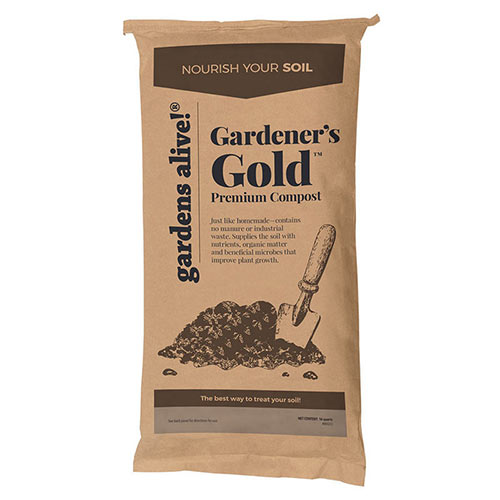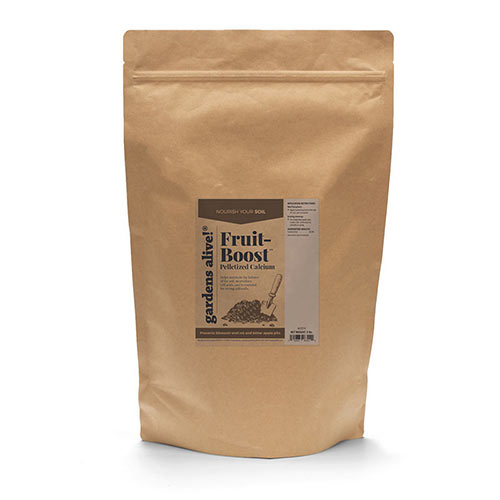A New Look at Elderberries
-
Helpful Products from Gardens Alive!
-
 Gardener's Gold™ Premium Compost
Gardener's Gold™ Premium Compost -
 Fruit-Boost™ Pelletized Calcium Carbonate
Fruit-Boost™ Pelletized Calcium Carbonate
Slater (who listens to us on WPSU from State College, PA), can't get enough about elderberries. He writes: "I'm hoping you will go into more detail about elderberries and tap into the enthusiastic cult following that these fruits are gaining the way you did with, say, persimmons a few years ago.
"Two decades ago, when I built my house in the mountains surrounding Williamsport, elderberries grew wild. I didn't like the taste and I considered them a horrible, bushy weed to be eradicated. Now I love them. Here's what I have learned:
*Although elderberry is streaking to popularity in America, as evidenced by an elderberry section in every drug store, 90% of the berries used are imported, dried, and from Europe; not because growing conditions are any better there; just that European Elderberries have been established as medicinally useful for a long time. Terry Durham in Missouri is trying to promote the American Elderberry. The Johnny Appleseed of elderberries, he's appeared on many YouTube channels and podcasts, and is a wealth of information.
*There have been remarkable advances in cultivars. Did you know that there are determinate and indeterminate (Wyldwood) varieties, just like tomatoes? And just like tomatoes, that determines if they all ripen at once or go on bearing until frost. There are varieties that hang the berries upside down so the birds can get some but leaving lots for humans. I have native varieties growing here in north-central PA, but the new varieties thrive here too. Terry provides cuttings to gardeners and farmers alike.
*There is no arguing: plain elderberries taste terrible by themselves. The traditional way to make them tasty was sugar and lemon juice. However, I mix a little elderberry juice with apple or orange juice (no added sugar) and it's delicious--more than the sum of the parts. {McGrath here: DELICIOUS orange juice is loaded with natural sugars. And it's delicious. Or did I say that already?}
* In a recent phone call, you went on at some length about elderberries containing cyanide. The same could be said for almonds, lima beans, bamboo shoots and spinach. Certain varieties contain more than others, but you correctly said that they should be cooked and then it all becomes moot.
*Deer eat elderberry leaves--I speak from experience. First year plants should be protected with wire fencing or some other type of deer deterrent. Deer will nibble on older plants but it's hardly noticeable because their growth is so vigorous. All in all, elderberries are the easiest berry I've ever grown. Propagation is just pushing a stick into the ground, where it roots with ease.
*I think you should have Terry Durham as a guest; his website is https://www.riverhillsharvest.com/ . PS: I also got my cuttings there."
A. I am keen on revisiting this topic because I have a long history with Elderberry. Back in the 90s, the late but still great James Duke, Ph. D. (who played THE leading role in researching the potential medicinal value of plants at the USDA for 27 years) recommended I try a new product called Sambucol, which he considered an excellent anti-viral.
Created by a female doctor of African origin in Israel, this was a refined product of ripe European (black) Elderberries (plus a little sugar so you didn't gag) that showed great potential in fighting viruses like the flu and the common cold (Rhinovirus). Tested during a particularly nasty flu outbreak in Israel in 1993, "Sambucol" was able to relieve flu symptoms in 90 percent of those who took it within three days. Non-users suffered symptoms for a week.
In 1993 I had a five-year-old and a three-year-old. My wife and I and both kids started taking the recommended 'prevention dose' as soon as summer was over. The kids were 'OK' with the flavor, but actually started asking for it when their classmates went down, once saying "half the school (or preschool) is sick; think we should double down?"
I still use the product or a similar one every flu season.
The scientific name of the plant is Sambucus. All or most of the natural medicinal products are made with European black elderberries, because that's what was used in the research. But as our friend Slater notes, there is also an elderberry native to North America named Sambucus Canadensis (either because it was first described in Canada or has something to do with yeast infections). And, as he notes, there is a {wait for it} 'growing interest' {MOAN< GROAN< RIM SHOT} in this native plant.
Now, about the cyanide precursors we focused on in that recent phone call. Numerous Universities in Missouri have been teaming up to research all aspects of the American Elderberry, hoping to make it a new cash crop in the state. I have read as much of the research as my brain can absorb, and the idea of cyanide being most prominent in the seeds seems to be incorrect.
The most dangerous parts of the plant seem to be the unripe fruit, stems and leaves. And researchers note that there's a heck of a lot more cyanide in apple seeds than in the worst parts of an elderberry plant. We'll provide a link to the most authoritative article I found (from the Journal "Molecules") , but for now, only use ripe berries and cook them well.
"Two decades ago, when I built my house in the mountains surrounding Williamsport, elderberries grew wild. I didn't like the taste and I considered them a horrible, bushy weed to be eradicated. Now I love them. Here's what I have learned:
*Although elderberry is streaking to popularity in America, as evidenced by an elderberry section in every drug store, 90% of the berries used are imported, dried, and from Europe; not because growing conditions are any better there; just that European Elderberries have been established as medicinally useful for a long time. Terry Durham in Missouri is trying to promote the American Elderberry. The Johnny Appleseed of elderberries, he's appeared on many YouTube channels and podcasts, and is a wealth of information.
*There have been remarkable advances in cultivars. Did you know that there are determinate and indeterminate (Wyldwood) varieties, just like tomatoes? And just like tomatoes, that determines if they all ripen at once or go on bearing until frost. There are varieties that hang the berries upside down so the birds can get some but leaving lots for humans. I have native varieties growing here in north-central PA, but the new varieties thrive here too. Terry provides cuttings to gardeners and farmers alike.
*There is no arguing: plain elderberries taste terrible by themselves. The traditional way to make them tasty was sugar and lemon juice. However, I mix a little elderberry juice with apple or orange juice (no added sugar) and it's delicious--more than the sum of the parts. {McGrath here: DELICIOUS orange juice is loaded with natural sugars. And it's delicious. Or did I say that already?}
* In a recent phone call, you went on at some length about elderberries containing cyanide. The same could be said for almonds, lima beans, bamboo shoots and spinach. Certain varieties contain more than others, but you correctly said that they should be cooked and then it all becomes moot.
*Deer eat elderberry leaves--I speak from experience. First year plants should be protected with wire fencing or some other type of deer deterrent. Deer will nibble on older plants but it's hardly noticeable because their growth is so vigorous. All in all, elderberries are the easiest berry I've ever grown. Propagation is just pushing a stick into the ground, where it roots with ease.
*I think you should have Terry Durham as a guest; his website is https://www.riverhillsharvest.com/ . PS: I also got my cuttings there."
A. I am keen on revisiting this topic because I have a long history with Elderberry. Back in the 90s, the late but still great James Duke, Ph. D. (who played THE leading role in researching the potential medicinal value of plants at the USDA for 27 years) recommended I try a new product called Sambucol, which he considered an excellent anti-viral.
Created by a female doctor of African origin in Israel, this was a refined product of ripe European (black) Elderberries (plus a little sugar so you didn't gag) that showed great potential in fighting viruses like the flu and the common cold (Rhinovirus). Tested during a particularly nasty flu outbreak in Israel in 1993, "Sambucol" was able to relieve flu symptoms in 90 percent of those who took it within three days. Non-users suffered symptoms for a week.
In 1993 I had a five-year-old and a three-year-old. My wife and I and both kids started taking the recommended 'prevention dose' as soon as summer was over. The kids were 'OK' with the flavor, but actually started asking for it when their classmates went down, once saying "half the school (or preschool) is sick; think we should double down?"
I still use the product or a similar one every flu season.
The scientific name of the plant is Sambucus. All or most of the natural medicinal products are made with European black elderberries, because that's what was used in the research. But as our friend Slater notes, there is also an elderberry native to North America named Sambucus Canadensis (either because it was first described in Canada or has something to do with yeast infections). And, as he notes, there is a {wait for it} 'growing interest' {MOAN< GROAN< RIM SHOT} in this native plant.
Now, about the cyanide precursors we focused on in that recent phone call. Numerous Universities in Missouri have been teaming up to research all aspects of the American Elderberry, hoping to make it a new cash crop in the state. I have read as much of the research as my brain can absorb, and the idea of cyanide being most prominent in the seeds seems to be incorrect.
The most dangerous parts of the plant seem to be the unripe fruit, stems and leaves. And researchers note that there's a heck of a lot more cyanide in apple seeds than in the worst parts of an elderberry plant. We'll provide a link to the most authoritative article I found (from the Journal "Molecules") , but for now, only use ripe berries and cook them well.
-
Helpful Products from Gardens Alive!
-
 Gardener's Gold™ Premium Compost
Gardener's Gold™ Premium Compost -
 Fruit-Boost™ Pelletized Calcium Carbonate
Fruit-Boost™ Pelletized Calcium Carbonate







 Gardens Alive! & Supplies
Gardens Alive! & Supplies




